<< Previous | Displaying results 6076-6100 of 6769 for "" | Next >>
Best friends Ejanga Egiomue (left) and Magdalene Garber (right) on an outing in Berlin, Germany during World War II (likely 1941-1942). Magdalene stayed in Germany, but Ejanga fled to Denmark in 1944. Both women survived the war and stayed in contact with each other, exchanging letters and correspondence well into the 1990s. Magdalene (“Leni”) Garber was born in January, 1919 in Germany. Her parents were Joseph Garber, a Togolese man, and Johanna Maychrzak, a white German woman. Magdalene grew up in…
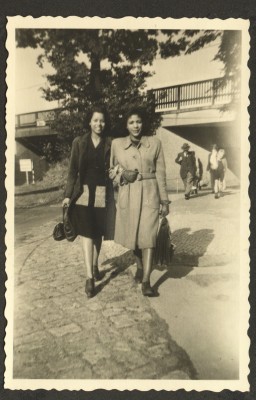
Magdalene Garber with friends and family at the public beach in Wannsee, Berlin, around 1940-1941. There are Nazi flags visible in the background behind Magdalene. Magdalene (“Leni”) Garber was born in January, 1919 in Germany. Her parents were Joseph Garber, a Togolese man, and Johanna Maychrzak, a white German woman. Magdalene grew up in Berlin-Neukölln and worked as a performer from an early age. She was part of several ethnographic shows, including a variety of Mohamed ben Ahmed’s Afrika-Schau…
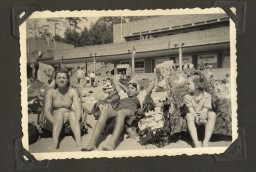
A wartime photograph of Magdalene Garber in the 1940s, likely taken in Berlin, Germany. Magdalene (“Leni”) Garber was born to Joseph Garber, a Togolese man, and Johanna Maychrzak in January 1919 in Germany. Magdalene grew up in Berlin-Neukölln and worked as a performer from an early age. She was part of several ethnographic shows, including a variety of Mohamed ben Ahmed’s Afrika-Schau during the late 1920s through the early 1930s, and the German Africa Show (Deutsche Afrika-Schau) during the Nazi…
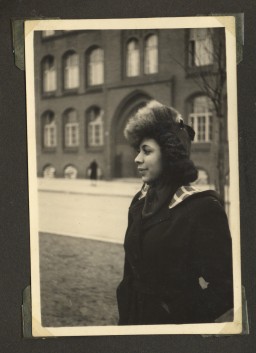
Party scene from the early 1940s in Germany. In the foreground is Deska Garber. Deska’s father was Joseph Garber, a Togolese man, and his mother was Johanna Maychrzak, a white German woman. The woman in the back left is Else Hummel, whom Deska would marry after the war. A small portrait of Adolf Hitler is visible on the wall in the background, something that would have been very common in German homes during the Nazi era.

This photograph shows a market scene at the main square in Lwów, Poland, shortly before the outbreak of World War II. Sitting on the fountain is a man holding a chicken and a basket, likely filled with groceries. His long beard and style of dress, including the overcoat and fedora, identify him as a more traditional, religious Jew. Traditionally, observant Jewish men wore beards and kept their heads covered. An elderly woman selling produce sits on the pavement near the man. In contrast to the man, the…
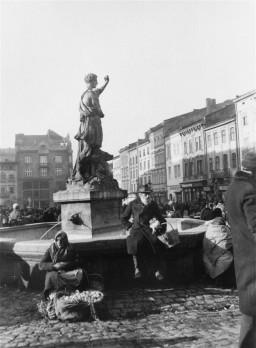
This portrait from around 1922 depicts three generations of the Menaker family. The hairstyles and clothing highlight the process of acculturation–adapting to and even adopting elements of the dominant, non-Jewish culture–in one Jewish family in the Lwów region. The older female relative wears a wig and a dress with long sleeves and a high collar. Orthodox Jewish women traditionally wore modest clothing and covered their hair with wigs or kerchiefs. By contrast, Szprinca (center) wears a dress with…
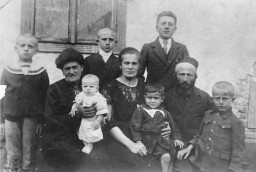
This 1935 portrait shows Samuel and Adela Shiber with three of their children—Salomon (left), Matylda (center), and Emanuel (right). The Shibers were a Jewish family from Lwów. Samuel owned a textile workshop in the city. Samuel and Adela spoke Yiddish at home, while the children spoke Polish among themselves. In this photo, there are no obvious markers of Jewish identity. The family wears clothing typical for middle or upper class families at the time. The children are dressed like most schoolchildren…
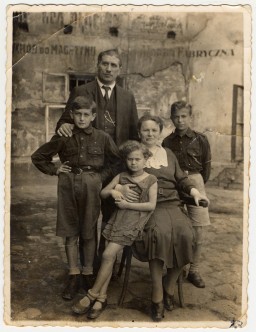
This prewar photo shows newly married Daniel and Laura (née Litwak) Schwarzwald enjoying a day on the beach in Zaleszczyki, Poland (today Zalishchyky, Ukraine). The Schwarzwalds were Jews from Lwów. They married in 1935 and lived in a fashionable Lwów district where Jews were a minority. Both Laura and Daniel pursued university educations and spoke Polish, Russian, German, and Yiddish. Daniel also spoke English. At the time of their marriage, Daniel was a successful businessman. He owned a lumber…

Propaganda played a crucial role in selling the myth of the "national community" (Volksgemeinschaft) to so-called "Aryan" Germans. The photograph on this cigarette card was taken by Nazi propagandist Heinrich Hoffman. It depicts a crowd of people smiling and giving the Nazi salute as a guard holds them back. Written in German, the caption on the back reads, "Every day the same picture: Fans welcome the leader." Beginning in the 1920s, cigarette cards were a popular collectible item in Germany. This card…
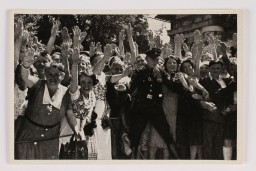
Sir Horace Rumbold was the British ambassador to Germany from 1928 to 1933. Rumbold described for the British government the changes he saw in Germany once Hitler came to power in January 1933. In a dispatch dated April 26, 1933, he warned of the principles outlined in Hitler's Mein Kampf and wrote that "the outlook for Europe is far from peaceful." Undated photograph. Library of Congress, Prints & Photographs Division, LC-DIG-ggbain-36812
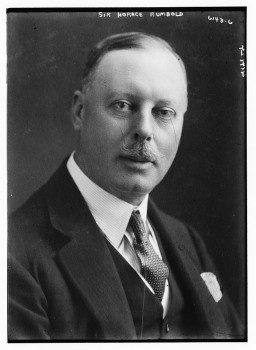
Standing in an open car, Adolf Hitler salutes a crowd in Hamburg, Germany. Photo dated August 17, 1934.
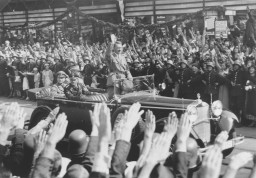
Hitler inspects a German naval warship. On his left is Admiral Erich Raeder. Standing to the right of Hitler is most likely Captain Hermann von Fischel, commander of the Deutschland from April 1, 1933, to December 29, 1935. Bremerhaven, Germany, circa 1933–1935.
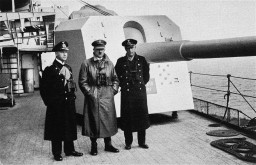
Portrait of British Prime Minister Neville Chamberlain. London, England, 1937–1940.
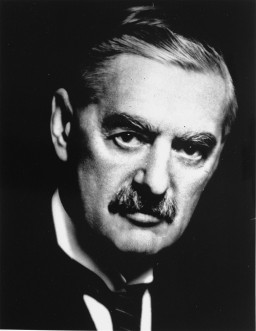
Members of the British Auxiliary Territorial Service carry rifles shipped from the United States under the Lend-Lease Act. Lend-Lease was a US policy that extended material aid to the Allies before and after the United States entered World War II.
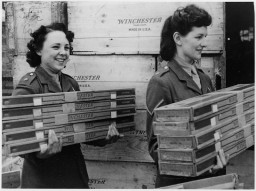
Wearing numbers, the defendants in the Bergen-Belsen Trial sit in the courtroom in Lüneburg, Germany. The Belsen Trial began on September 17, 1945, and was one of the first war crimes trials held after World War II. IWM (HU 59545)
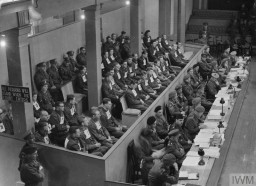
British Prime Minister Winston Churchill sits in the Cabinet Room at 10 Downing Street. London, 1940. IWM (MH 26392)
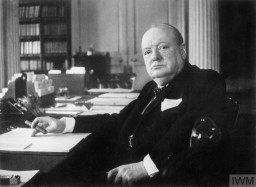
Winston Churchill (seated) at Westminster College on March 5, 1946, the day he delivered his “Iron Curtain” speech. Standing at the far right is US President Harry S. Truman. Behind them (left to right) are Admiral William D. Leahy, Captain Clark Clifford, and Major General Harry Vaughan. Photograph taken by Terry Savage. Fulton, Missouri.
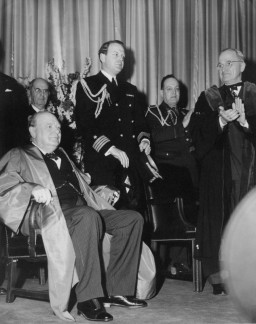
British Prime Minister Winston Churchill (far right) and others view buildings damaged during the Blitz. The Blitz was a German bombing campaign over Britain that lasted from September 7, 1940, to May 11, 1941. London, September 8, 1940. IWM(H 3978)
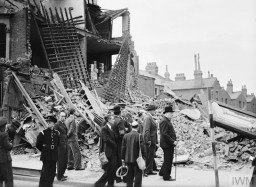
British Prime Minister Neville Chamberlain addresses a crowd at the Heston Aerodrome on September 30, 1938. He has just returned from signing the Munich Agreement with Germany, Italy, and France. Chamberlain will later deliver a statement at the prime minister’s residence at 10 Downing Street, where he famously proclaims, “I believe it is peace for our time.” IWM (HU 4255)
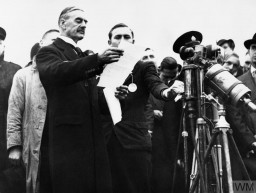
Destroyers of the Royal Navy carry British troops evacuated from Dunkirk. Dover, England, May 31, 1940. IWM (H 1640)
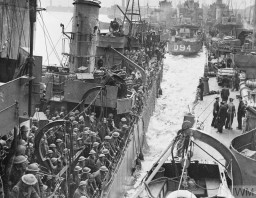
President Franklin D. Roosevelt and British Prime Minister Winston Churchill during the Atlantic Conference on Placentia Bay in Newfoundland, Canada. Also pictured are the president’s sons, Franklin D. Roosevelt, Jr. (far left) and Elliott Roosevelt (far right). August 9, 1941.

A sergeant pilot of the British Royal Air Force sits in the cockpit of his Spitfire in September 1940. Between July 10 and October 31, 1940, Germany and Britain fought for air control of the English Channel in the Battle of Britain. IWM (HU 104502)
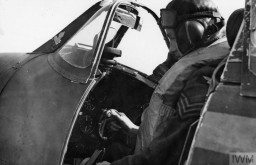
Sergeant Leon Bass and other members of the all African-American 183rd unit witnessed Buchenwald several days after liberation.
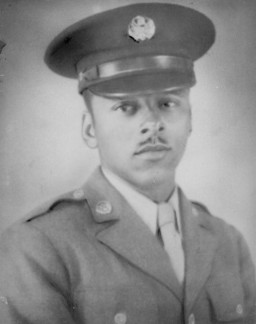
Police search members of the SA (Sturmabteilung) for weapons as they gather for a rally. This photo was taken during the years of the Weimar Republic, before the Nazi rise to power. Germany, 1929–1932.
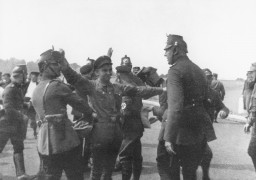
Collage created after the Nazi regime began to force gay and lesbian gathering spaces to close. It was published in the magazine, Der Notschrei. Berlin, March 1933.
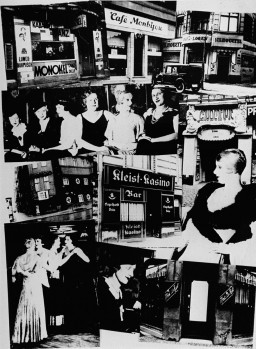
We would like to thank Crown Family Philanthropies, Abe and Ida Cooper Foundation, the Claims Conference, EVZ, and BMF for supporting the ongoing work to create content and resources for the Holocaust Encyclopedia. View the list of donor acknowledgement.